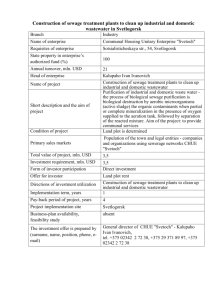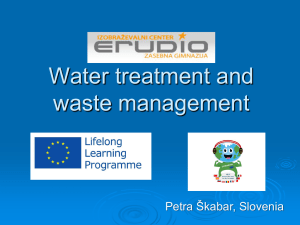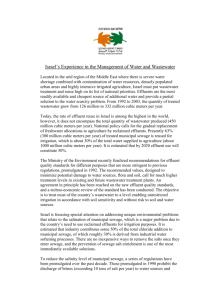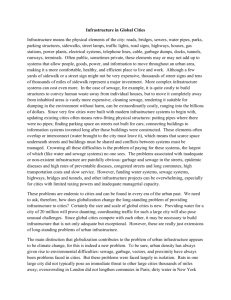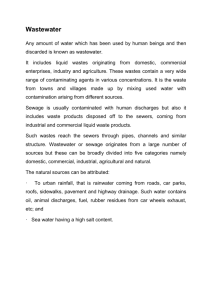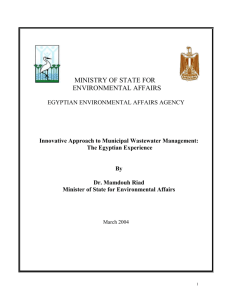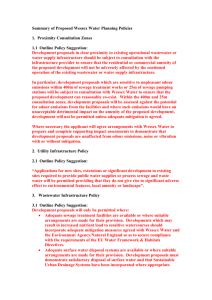CHAPTER 1
advertisement
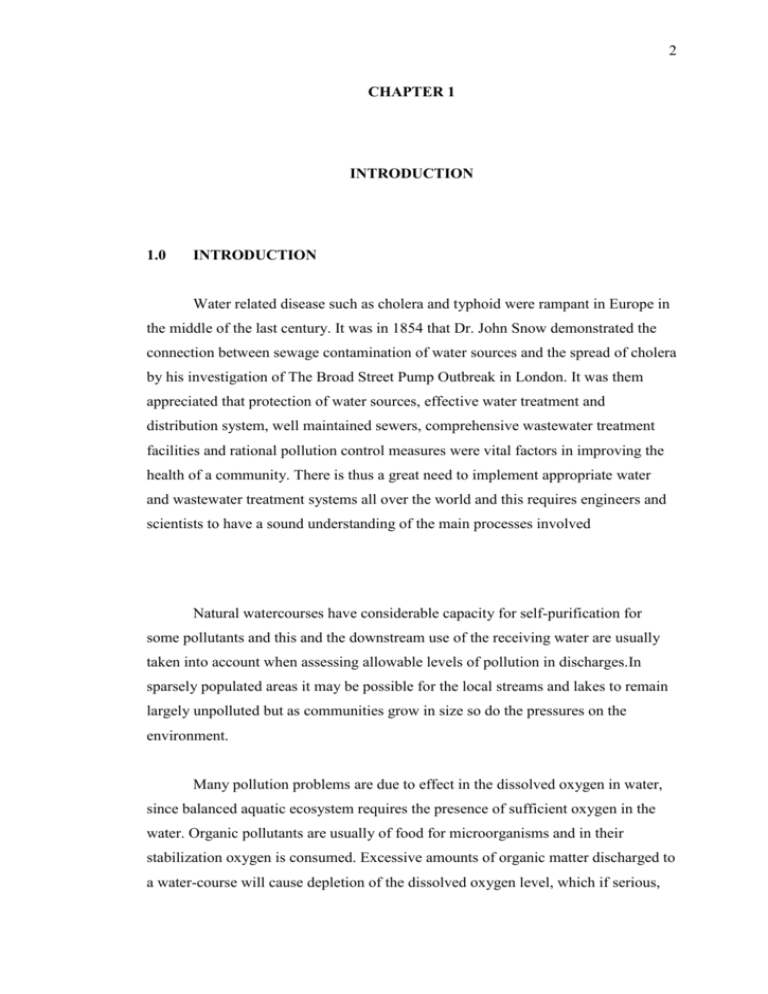
2 CHAPTER 1 INTRODUCTION 1.0 INTRODUCTION Water related disease such as cholera and typhoid were rampant in Europe in the middle of the last century. It was in 1854 that Dr. John Snow demonstrated the connection between sewage contamination of water sources and the spread of cholera by his investigation of The Broad Street Pump Outbreak in London. It was them appreciated that protection of water sources, effective water treatment and distribution system, well maintained sewers, comprehensive wastewater treatment facilities and rational pollution control measures were vital factors in improving the health of a community. There is thus a great need to implement appropriate water and wastewater treatment systems all over the world and this requires engineers and scientists to have a sound understanding of the main processes involved Natural watercourses have considerable capacity for self-purification for some pollutants and this and the downstream use of the receiving water are usually taken into account when assessing allowable levels of pollution in discharges.In sparsely populated areas it may be possible for the local streams and lakes to remain largely unpolluted but as communities grow in size so do the pressures on the environment. Many pollution problems are due to effect in the dissolved oxygen in water, since balanced aquatic ecosystem requires the presence of sufficient oxygen in the water. Organic pollutants are usually of food for microorganisms and in their stabilization oxygen is consumed. Excessive amounts of organic matter discharged to a water-course will cause depletion of the dissolved oxygen level, which if serious, 3 may kill most forms of aquatic life. Pollution control measures are thus aimed at ensuring satisfactory dissolved oxygen concentrations in the receiving water, removing excessive amounts of suspended matter and preventing the discharge of toxic materials which would prevent full use of the water for other purposes. To treat the pollutant water, there are various techniques attempted in order to improve the sources of water whether with chemical reaction, mechanical action, plant removal and natural microorganism. The natural microorganism is mostly encouraged as the reaction are natural and produced; if any, minor long term effects. 1.1 Problem Background Existing Sewage Treatment Plants (STP) in Malaysia which are mostly Oxidation Ponds have always faced with problems attaining the required Department of Environment (DOE) effluent standards. Major problems related to odour emission, instability in treatment process and excess sewage production persisted until today. Effluents from wastewater become a big problem for those involved in wastewater treatment industry such as Indah Water Konsortium. Sometimes the effluents become another problem to the environmental such as effluent discharge having highly non-biodegradable organic, odour problem, colour and others. The common outcry from the public is smell problem emitted from the pond. Smell could be traced up till three kilometre away from the oxidation pond especially when in the morning and after rain, when the air is moistured. However, odour control technology such as odour scrubber placed at almost sewage treatment plant required such high costs depending on the concentration and size of the sewage treatment plant. As an alternatives to reduce the cost, the application of bio-chemical products are hoped to overcome this odour problem, at the same time improve the quality of the treated sewage and sludge generated. 4 Bio chemical product is a new technology of natural and environmental friendly consisting of chemical and physical properties. Bacterial /enzymes concentrate is efficient at digesting various toxicants in waste treatment system. It reacts by maintaining the natural balance and eliminating unnatural and unfriendly microorganisms present in the polluted water continuously. The biochemical product used in this study is Eco Bio Block (EBB) . It is a solid, block manufactured through stringent process of mixing the precise amount of cement, sand, stone, environmentally friendly microorganisms with special nourishment and volcanic stone. It infused microorganisms into cement blocks, which treat polluted water by maintaining the natural balance and eliminating unnatural and unfriendly microorganisms present in the polluted water continuously. The development of EBB was built since 16 years ago. Malaysia has been the first country to adapt this technology to treat wastewater. The pioneer projects were done to treat Sungai Melaka and Parit Kuah at Padang Mat Silat, Langkawi, Kedah. Another project were carried out at Putrajaya Wetland and Sungai Damansara. This study is carried out to determine the potential usage of Eco Bio Block as a biochemical product to upgrade the performance of STP. Sewage treatment plant at Rumah Pangsa Kulai was selected for the purposed of the study. The technical aspects of its mechanism, process, application, locating, hydraulic and hydrological data was look into the process of enhancing the beneficial biological and microorganism activities in the treatment plant, which could assist in improving the treatment performance as well as to upgrade the treatment capability of the sewage treatment plant. 1.2 Objectives 5 The aim of this study is generally to investigate the potential usage of applying bio-chemical products selected in assisting and improving the performance of the sewage treatment plant. Major objectives are: (i) To study and understand the behaviour of bio-chemical products in sewage treatment process (ii) To study the effectiveness of biochemical products in the treatment plant – through : o Quality of effluent before, during and after application o Sludge minimisation o Maintenance efficiency 1.3 Scope of Work This study involves selection of potential biochemical products dosed in sewage treatment (oxidation pond) at Kulai Flat House, Senai Area. Biochemical products Eco Bio Block is chosen. Selected parameters at different point are analysed, which includes in-situ and laboratory analysis. The monitoring and sampling are conducted based on scheduled time 6

